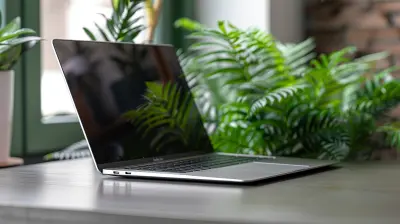1 March 2025
Let’s face it, we live in a world where our gadgets are practically glued to us. Whether it’s your smartphone, laptop, tablet, or even your smartwatch, these little pieces of tech are indispensable. But when you're traveling, especially to unfamiliar places, keeping your gadgets safe can sometimes feel like playing a game of cat and mouse. You’ve got enough on your plate with figuring out flight times and hotel check-ins, so the last thing you want is to worry about losing or damaging your cherished tech.
In this guide, we'll walk you through some practical, effective, and downright easy ways to keep your gadgets safe while traveling. Whether you’re going on a business trip or a relaxing vacation, these tips will ensure your tech stays as safe as you are.

Why Protecting Your Gadgets While Traveling is Important
Before we dive into the tips, let’s get one thing clear: traveling can be rough on your gadgets. From the moment you leave your house until you return, your devices are exposed to all sorts of risks—loss, theft, damage, you name it. Not only are your gadgets expensive, but they also contain sensitive personal data that could be compromised.Think about it: your phone holds your contacts, emails, banking information, and perhaps even your social media accounts. If someone were to get their hands on it, they could wreak havoc on your life. And let’s not even begin to talk about the inconvenience of losing your laptop or camera mid-trip. It’s a headache no one wants to deal with.
That’s why knowing how to protect your tech when you’re on the go is crucial. So, let’s get into it!
1. Use a Sturdy, Well-Padded Bag
First thing’s first: invest in a good travel bag. This may sound obvious, but you’d be surprised how many people throw their expensive gadgets into flimsy bags with little to no protection. A sturdy, well-padded bag can be a lifesaver for your gadgets, especially if you’re carrying laptops, tablets, or cameras.Look for bags that have specific compartments for your devices. Many travel bags come with padded laptop sleeves or small pockets for tablets and smartphones. This extra padding can protect your gadgets from bumps, drops, and even minor water splashes.
Also, consider a bag with anti-theft features like hidden zippers, slash-resistant material, or built-in locks. Thieves often target travelers because they know that tourists aren’t always paying attention to their surroundings. Having a bag that’s a bit more secure can make all the difference.
Pro Tip:
Opt for backpacks or crossbody bags rather than handbags or totes. Backpacks distribute weight evenly and are harder for thieves to snatch compared to shoulder bags.
2. Backup Your Data Before You Leave
Let’s say you do everything right, but somehow, your phone still gets stolen, or your laptop gets damaged. The worst-case scenario? Losing all your precious data. That’s why backing up your data before you leave is a non-negotiable step.Whether you use cloud storage (e.g., Google Drive, iCloud, Dropbox) or an external hard drive, make sure all your important files, photos, and documents are safely backed up. Should the unthinkable happen, you can at least breathe a sigh of relief knowing your data is still intact.
For mobile devices, ensure that automatic cloud backups are turned on. For laptops, manually backup your files onto a portable drive or use cloud services. This extra step can save you hours of stress later on.
3. Keep Your Gadgets With You at All Times
This one may seem like a no-brainer, but you’d be surprised how often people leave their gadgets unattended. Whether you're at an airport, a café, or even a hotel lobby, never leave your devices out of your sight. Keep them close, like you would your wallet or passport.If you're taking a flight, always keep your gadgets in your carry-on luggage. Checked bags are more likely to get lost or mishandled, and even if they don’t, they aren’t exactly handled with care. Your devices are much safer with you in the cabin.
Also, remember not to leave your gadgets in plain sight when you’re out and about. It’s like leaving a $100 bill on the table—it’s just asking for trouble. If you’re in a restaurant or a public place, keep your devices in your bag or pocket.
Pro Tip:
If you must leave your gadgets in a hotel room, use the room safe if one is provided. It’s not foolproof, but it’s better than leaving your devices out in the open.4. Use Strong Passwords and Two-Factor Authentication
We all know how important passwords are, but when you’re traveling, their importance skyrockets. If your device falls into the wrong hands, a strong password is your first line of defense. Use strong, unique passwords for all your devices and accounts.Better yet, enable two-factor authentication (2FA) wherever you can. This adds an extra layer of security, requiring not just a password, but also a code sent to your phone or email. Even if someone manages to crack your password, they’ll have a much tougher time getting through 2FA.
If you’re bad at remembering passwords (aren’t we all?), consider using a password manager. These tools can generate and store complex passwords for you, so you don’t have to.
5. Consider Using Tracking Apps
Have you ever lost your phone or laptop and wished there was a way to track it down? Good news: there is! Many devices now come with built-in tracking features that allow you to locate your gadget if it’s lost or stolen.For iPhones and iPads, you can use the “Find My” app. Android users have the “Find My Device” feature. Both of these allow you to track your device’s location in real-time, lock it, or even wipe it remotely if necessary.
For laptops, services like Prey or LoJack for Laptops can help you track them if they go missing. These apps can also take pictures of whoever has your laptop (creepy, but effective!) and send them to you.
Pro Tip:
Make sure these tracking apps are set up and working before you leave on your trip. Trust me, the last thing you want to do is try to figure it out after your gadget is already lost.6. Avoid Public Wi-Fi (Or Use a VPN)
Public Wi-Fi networks are convenient, but they’re also a playground for hackers. Avoid connecting to unsecured Wi-Fi networks, especially if you're accessing sensitive information like banking or personal accounts.If you absolutely must use public Wi-Fi, make sure you’re using a Virtual Private Network (VPN). A VPN encrypts your internet connection, making it much harder for hackers to intercept your data.
There are plenty of affordable VPN options out there—NordVPN, ExpressVPN, and CyberGhost are some popular ones. If you travel frequently, investing in a good VPN is definitely worth it.
7. Protect Your Gadgets From Water and Extreme Temperatures
Water and electronics don’t mix—we all know that. But when you’re traveling, your gadgets are more likely to come into contact with water or moisture, whether it’s from a rainy day, a spilled drink, or even a dip in the pool.To protect your devices, consider investing in waterproof cases or sleeves. These are especially useful if you're planning to spend time outdoors, at the beach, or anywhere near water.
Likewise, extreme temperatures can damage your gadgets. Try not to leave your devices in direct sunlight for long periods, and avoid exposing them to extreme cold. Both can cause internal damage to batteries and screens.
8. Get Travel Insurance for Your Gadgets
We insure our cars, our homes, and even our pets, so why not insure our gadgets? Travel insurance can cover your gadgets in case they’re lost, stolen, or damaged while you’re on the go. Many travel insurance policies offer gadget-specific coverage, so be sure to check your options.If your current travel insurance doesn’t cover gadgets, look for a policy that does. Some policies even offer coverage for high-end devices like cameras, drones, and laptops. It’s a small price to pay for peace of mind.
9. Don’t Overpack Your Gadgets
This might be hard to hear, but leave some of your gadgets at home. Do you really need to bring your tablet, laptop, smartphone, camera, and smartwatch all in one trip? The more devices you carry, the more you have to keep track of—and the higher the risk of something going wrong.Think about what you'll actually use on your trip. If you're going on a digital detox, maybe leave the laptop behind. If you're going somewhere scenic, maybe the camera is all you need. Pack smart, and keep it simple.
10. Use a Portable Power Bank
One of the most frustrating things that can happen while traveling is running out of battery with no way to charge your device. Carrying a portable power bank ensures that your devices never run out of juice at critical moments.Power banks come in all shapes and sizes. Look for one that has enough capacity to charge your main devices at least once. Some power banks even come with multiple ports, allowing you to charge more than one device at a time. Just make sure to charge your power bank before you leave your hotel for the day!
Final Thoughts
Traveling with gadgets doesn’t have to be stressful. By following these tips, you can keep your devices safe from harm and enjoy your trip without constantly worrying about your tech. Whether you’re a business traveler, a photographer, or just someone who loves their gadgets, a little preparation goes a long way.So, the next time you’re packing for a trip, remember: Protect your gadgets like you would protect yourself. After all, they’re your travel companions too!













Soraya Rogers
This article offers valuable insights on safeguarding our tech while on the go. From using anti-theft bags to enabling tracking features, the tips are practical and easy to implement. It’s a reminder that a little preparation can go a long way in protecting our essential gadgets during travel.
April 5, 2025 at 4:05 AM